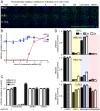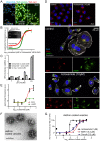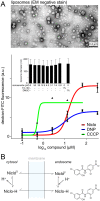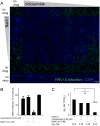Niclosamide is a proton carrier and targets acidic endosomes with broad antiviral effects
- PMID: 23133371
- PMCID: PMC3486884
- DOI: 10.1371/journal.ppat.1002976
Niclosamide is a proton carrier and targets acidic endosomes with broad antiviral effects
Abstract
Viruses use a limited set of host pathways for infection. These pathways represent bona fide antiviral targets with low likelihood of viral resistance. We identified the salicylanilide niclosamide as a broad range antiviral agent targeting acidified endosomes. Niclosamide is approved for human use against helminthic infections, and has anti-neoplastic and antiviral effects. Its mode of action is unknown. Here, we show that niclosamide, which is a weak lipophilic acid inhibited infection with pH-dependent human rhinoviruses (HRV) and influenza virus. Structure-activity studies showed that antiviral efficacy and endolysosomal pH neutralization co-tracked, and acidification of the extracellular medium bypassed the virus entry block. Niclosamide did not affect the vacuolar H(+)-ATPase, but neutralized coated vesicles or synthetic liposomes, indicating a proton carrier mode-of-action independent of any protein target. This report demonstrates that physico-chemical interference with host pathways has broad range antiviral effects, and provides a proof of concept for the development of host-directed antivirals.
Conflict of interest statement
I have read the journal's policy and have the following conflicts: 3-V Biosciences is a commercial organization developing antiviral agents. 3-V Biosciences provided support for part of the research but had no decision on how to perform or publish the research. This does not alter our adherence to all PLoS Pathogens policies on sharing data and materials.
Figures






Similar articles
-
Chemical Evolution of Rhinovirus Identifies Capsid-Destabilizing Mutations Driving Low-pH-Independent Genome Uncoating.J Virol. 2022 Jan 26;96(2):e0106021. doi: 10.1128/JVI.01060-21. Epub 2021 Oct 27. J Virol. 2022. PMID: 34705560 Free PMC article.
-
Neutralization of Acidic Intracellular Vesicles by Niclosamide Inhibits Multiple Steps of the Dengue Virus Life Cycle In Vitro.Sci Rep. 2019 Jun 18;9(1):8682. doi: 10.1038/s41598-019-45095-1. Sci Rep. 2019. PMID: 31213630 Free PMC article.
-
Discovery of a Small Molecule Inhibitor of Human Adenovirus Capable of Preventing Escape from the Endosome.Int J Mol Sci. 2021 Feb 5;22(4):1617. doi: 10.3390/ijms22041617. Int J Mol Sci. 2021. PMID: 33562748 Free PMC article.
-
Therapeutic targets in respiratory viral infections.Curr Med Chem. 2007;14(26):2776-82. doi: 10.2174/092986707782360132. Curr Med Chem. 2007. PMID: 18045123 Review.
-
Emerging antiviral strategies to interfere with influenza virus entry.Med Res Rev. 2014 Mar;34(2):301-39. doi: 10.1002/med.21289. Epub 2013 Jun 25. Med Res Rev. 2014. PMID: 23801557 Free PMC article. Review.
Cited by
-
Mechanistic Understanding Enables the Rational Design of Salicylanilide Combination Therapies for Gram-Negative Infections.mBio. 2020 Sep 15;11(5):e02068-20. doi: 10.1128/mBio.02068-20. mBio. 2020. PMID: 32934086 Free PMC article.
-
A Repurposed Drug Screen for Compounds Regulating Aquaporin 5 Stability in Lung Epithelial Cells.Front Pharmacol. 2022 Jan 25;13:828643. doi: 10.3389/fphar.2022.828643. eCollection 2022. Front Pharmacol. 2022. PMID: 35145418 Free PMC article.
-
In Vitro Evaluation and Mitigation of Niclosamide's Liabilities as a COVID-19 Treatment.bioRxiv [Preprint]. 2022 Jul 13:2022.06.24.497526. doi: 10.1101/2022.06.24.497526. bioRxiv. 2022. Update in: Vaccines (Basel). 2022 Aug 09;10(8):1284. doi: 10.3390/vaccines10081284. PMID: 35860224 Free PMC article. Updated. Preprint.
-
Cation-π interactions drive hydrophobic self-assembly and aggregation of niclosamide in water.RSC Adv. 2021 Oct 7;11(52):33136-33147. doi: 10.1039/d1ra05358b. eCollection 2021 Oct 4. RSC Adv. 2021. PMID: 35493563 Free PMC article.
-
Niclosamide for Covid-19: bridging the gap.Mol Biol Rep. 2021 Dec;48(12):8195-8202. doi: 10.1007/s11033-021-06770-7. Epub 2021 Oct 18. Mol Biol Rep. 2021. PMID: 34664162 Free PMC article. Review.
References
-
- Fleming A (1929) On the antibacterial action of cultures of a penicillium, with special reference to their use in the isolation of B. influenzae. Br J Exp Path 10: 226–36. - PubMed
-
- Yazdanpanah Y (2009) Multidrug resistance: a clinical approach. Curr Opin HIV AIDS 4: 499–506. - PubMed
-
- Le Gall O, Christian P, Fauquet CM, King AM, Knowles NJ, et al. (2008) Picornavirales, a proposed order of positive-sense single-stranded RNA viruses with a pseudo-T = 3 virion architecture. Arch Virol 153: 715–727. - PubMed
-
- Fuchs R, Blaas D (2010) Uncoating of human rhinoviruses. Rev Med Virol 20: 281–297. - PubMed
Publication types
MeSH terms
Substances
LinkOut - more resources
Full Text Sources
Other Literature Sources
Molecular Biology Databases

